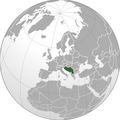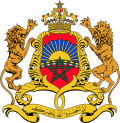Morocco–Yugoslavia relations
Morocco |
Yugoslavia |
|---|---|

Morocco–Yugoslavia relations were historical foreign relations between
The issue of Western Sahara in bilateral relations
Friendly initial relations between the two countries suffered from the unresolved issue of the Western Sahara which gained prominence among some Non-Aligned countries, including some of the major Yugoslav partners. As Yugoslavia was the first European country which recognized the independence of Algeria some NAM member states believed that they will be able to pressure Belgrade to be the first European country to recognize the Sahrawi Arab Democratic Republic.[4] During the Polisario Front visit to Belgrade led by Mustafa Ould Salek, Minister of Foreign Affairs of Yugoslavia Miloš Minić excused Yugoslav president from the meeting by his heavy workload burden at the time.[4] Minić and president Tito subsequently met Prime Minister of Morocco Maati Bouabid where the Western Sahara was discussed.[4] While Yugoslav side showed some dissatisfaction with perceived Moroccan rigidity over the issue, Moroccan side appreciated the friendly atmosphere in which concerns were shared.[4] On 28 November 1984 Yugoslavia recognized the Sahrawi Arab Democratic Republic.[5] Yugoslav recognition was 61 recognition and the first one (and alongside 1987 Albanian the only one) in Europe. This led to a 4 years long period of rupture in formal relations between the two countries. Yugoslav decision was subsequently recalled by Serbia and Montenegro (one of the successor states) in early 2000's which led to development of relations between Serbia and Morocco centered over the shared views on the status of Western Sahara and Kosovo.
List of bilateral state visits
Yugoslav visits to Morocco
- 1-6 March 1961: Josip Broz Tito[6]
See also
- Yugoslavia and the Non-Aligned Movement
- Yugoslavia and the Organisation of African Unity
- Morocco–European Union relations
- Yugoslavia–European Communities relations
- Mediterranean Games
- Agadir Crisis
- July Crisis
- Morocco in the Eurovision Song Contest
- Yugoslavia in the Eurovision Song Contest
- Death and state funeral of Josip Broz Tito
- Morocco at the 1984 Winter Olympics
References
- ^ "Мароко". Ministry of Foreign Affairs (Serbia). Retrieved 13 November 2020.
- ISBN 978-86-84811-45-7.
- ^ a b Jakovina, Tvrtko. "Yugoslavia on the International Scene: The Active Coexistence of Non-Aligned Yugoslavia". YU Historija. Retrieved 13 November 2020.
- ^ ISBN 978-953-266-203-0.
- Universidad de Santiago de Compostela. Retrieved 13 November 2020.
- ^ R. Radonić, Nemanja (2020). Слика Африке у Југославији (1945-1991) (PDF) (Doctoral Thesis). University of Belgrade. Retrieved 13 November 2020.





